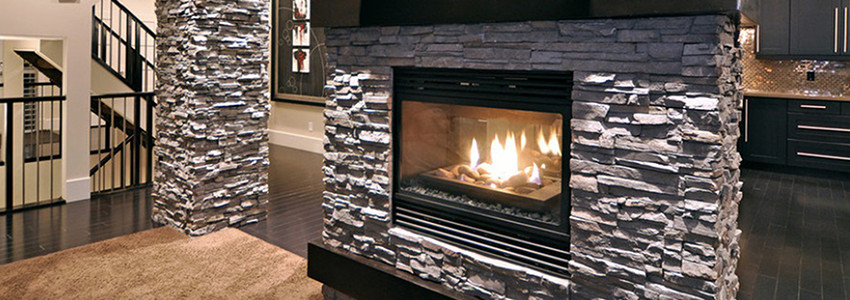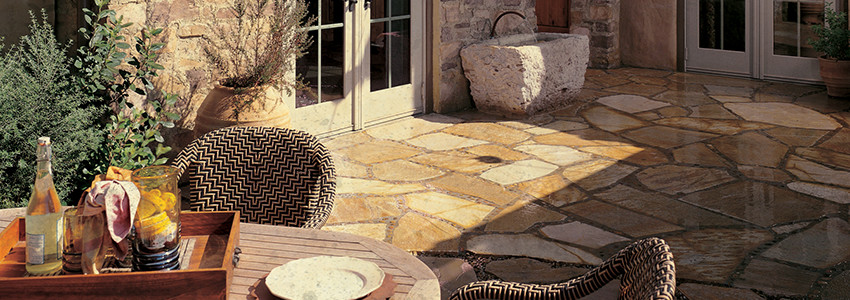Using stone in home beautification projects can make your spaces feel warm and look beautiful, as well as imbue different areas of your home with a unique connection to nature. Natural stone is relatively durable and can be installed using stonework techniques that will give a fireplace, walkway, floor, or wall classic impact or modern flair. The biggest challenge? Choosing from the myriad stone options on the market.
No one can make the choice for you but we can help by sharing the pros and cons of the most common stone types. Here's a short guide to choosing stone for your next remodeling endeavor.
Slate: Traditional and Rustic

This stone has been a staple of building for thousands of years because of its durability and how easy it is to work with. It also offers a distinctive resistance to freezing and thawing cycles for outside applications. In terms of color options, slate has a vibrant palette of hues beyond gray, including green, red, and purple with orange, gold, or copper mottling. Flooring is one of the most common applications of slate but slate can be used to create a durable, stain resistant countertop and slate roofs bring old world charm to new construction. The following pros and cons can help guide you to the most fitting applications for slate.
Pros
- Classically attractive with vibrant colors
- Easy to work with
- Resistant to cracks, scratches, breaks, and chips
Cons
- Susceptible to moisture damage
- Cold to the touch
Limestone: Distinctive and Simple

This stone weathers to a pleasing patina, and limestone's texture can even get better with age. It's this durability that has made it a favorite building material across generations, whether used as a landscape accent or as part of a home's interior or exterior structure. Color wise, the most common limestone varieties are dark gray, pale gray, blue gray, cream, and tan – and these colors are fine grained and even. The best places to use limestone inside the home are in the fireplace and flooring; outside of those areas let the following pros and cons guide you.
Pros
- Easy to shape
- Very evenly colored
- Texture improves over time
Cons
- Fewer color choices
- Susceptible to acid rain
- May stain
Granite: Long Lasting and Versatile

This stone is a go-to among builders and designers because of its extreme hardness, which makes it ideal for curbing, fireplaces, steps, and even kitchen countertops. It's beloved by homeowners, too, mainly because of the dizzying array of flecked color and swirling pattern choices available. A suitable granite can almost always be found to harmonize with any style of interior or exterior – and these can be polished to a sheen finish or set in other textures. All of this adds up to the fact that granite will almost always meet your building or remodeling needs, but there are both pros and cons to consider.
Pros
- Extremely durable
- Huge color and pattern range
- Naturally bacteria resistant
Cons
- Challenging to work with
- More expensive than other stone
- Requires regular resealing
Travertine: Warm and Elegant

This popular stone is often used for flooring, both inside and out, because it's long lasting and actually feels soft and warm underfoot. It's also a wonderful alternative to marble for anyone with children, grandchildren, or pets because it's much less sensitive – especially when used in flooring. A main drawback of travertine in its natural form is that it doesn't offer the shiny finish many people prefer. However, some people see the natural look of travertine as a distinct pro, as can be seen in the pros and cons below.
Pros
- Pleasant underfoot
- Unique matte finish
- Resembles marble
Cons
- Vulnerable to weak acidic liquids
- Highly porous and requires sealing or grouting
- Colors and patterns vary widely
Flagstone: Myriad Options for Every Application

Not just one type of stone, flagstone is actually any sedimentary rock that is split into layers across well defined planes to form flat slabs commonly used in walkways, inside and out. Because flagstones come in so many different colors, shapes, sizes, patterns, and textures, every flagstone floor is unique. For homeowners who prize individuality, this can be a major selling point. The earthy, timeless appearance of flagstone is another. Sandstone flagstone is one popular choice because of its durability and the many color options available, but the most important thing homeowners should know when choosing any flagstone variety is the maintenance requirements of their chosen stone. The pros and cons of flagstone are as varied as the stone itself.
Pros
- Unmistakable and timeless
- Fascinating color variations
- Resistant to scratches, breaks, and chips
Cons
- Different flagstones varieties require different maintenance
- Challenging to work with
- Subject to erosion
Of course, when it comes to stone types, maybe it's better to think in terms not of pros and cons but rather of the strengths each type of stone can bring to different projects, inside of the home and outside of it. Every stone has natural beauty and the true challenge is determining where that beauty can reach its full potential.
Related Categories
Technically SpeakingJeff Tew
As the Director of Technical and Training, Jeff Tew is an invaluable thought leader and resource for trade professionals. With more than 25 years of career experience in Manufactured Stone Veneer (MSV), he works with masons, builders, architects, and others in the construction industry to help design and build beautiful projects. As a firm believer in MSV as one of the industry's most efficient and resilient materials, Jeff knows it can be used to define unique and captivating spaces and buildings through proper planning, detailing and testing. Drawing on his experiences as a contractor during trainings and consultations, Jeff focuses on helping pros build healthy wall systems using MSV while meeting building code requirements and working safely on residential and commercial job sites all across North America.



Let Us Know What You Thought about this Post.
Put your Comment Below.